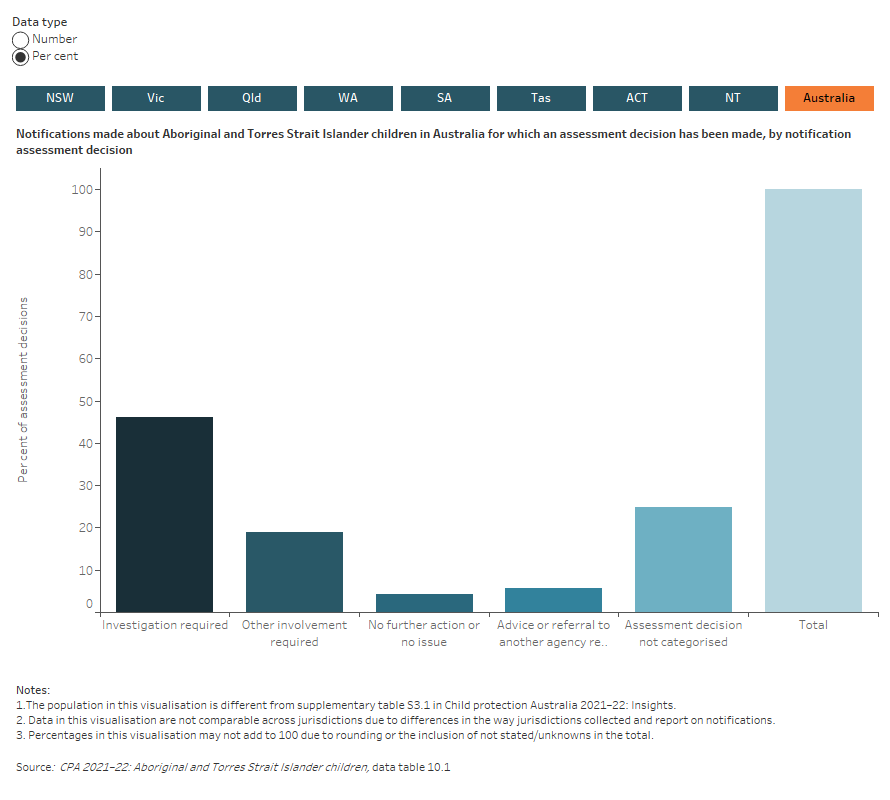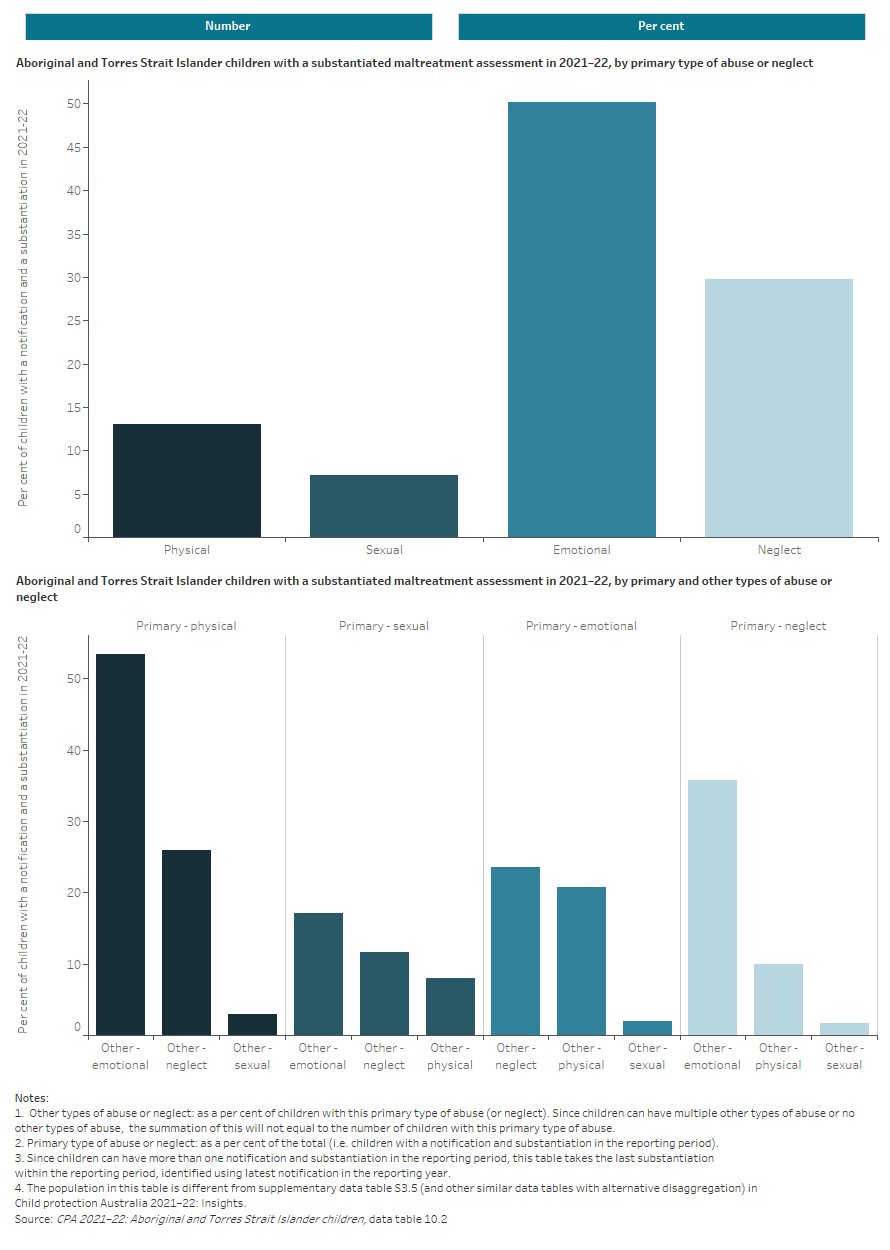Notifications, investigations and substantiations
Notifications are the entry point for children into the system. The notification triggers an intake process where child protection workers evaluate the notification and determine what action to take. An investigation occurs when a notification of alleged abuse meets the threshold for further action. At the conclusion of the investigation, the case manager will make a substantiation decision. An assessment of substantiation is made when a threshold of harm or potential harm is met.
Due to differences in the way jurisdictions collect and report on notifications, investigations and substantiations, data are not comparable between jurisdictions. Refer to the Appendices for more information on differences in jurisdictions’ policy and practice.
Refer to The process of determining child maltreatment section of Child protection Australia (CPA) 2021–22: Insights for more information on notifications, investigations and substantiations.
How many notification assessment decisions were made?
In 2021–22, child protection departments made an assessment decision for 129,000 notifications of alleged child maltreatment about Aboriginal and Torres Strait Islander children. Once a notification is received, the department will begin a process to determine the level of assistance they should provide in relation to the child who was the subject of a notification. In keeping with the prevention element of the ATSICPP, departments protect the rights of children to be brought up in their families, ensuring that families have equitable access to quality service supports. This includes having alternative intake and referral pathways to early intervention prior to families being investigated by the child protection system.
Source: CPA 2021–22: Aboriginal and Torres Strait Islander children, data table 10.1.
The prevention element of the ATSICPP relates to supporting families and building the capacity in communities to care safely for their children. This will protect future generations from the devastating effects of removal from family, community, culture and country (SNAICC 2017).
54% (69,200) of notifications with an assessment decision were resolved without an investigation. Of the notifications with an assessment decision (note this excludes New South Wales and Tasmainia, where notifications cannot be differentiated by some or all of these assessment decisions):
- about 19% (24,400) required other involvement, for example, in cases where the family needs are still being assessed and a case plan is developed
- 5.7% (7,400) were referred to other services or families were provided with advice
- 4.3% (5,600) did not require further action as the subject child was assessed as not being at risk of potential or actual harm.
Around 46% (59,500) of notifications were assessed as requiring an investigation (Figure 1).
Source: CPA 2021–22: Aboriginal and Torres Strait Islander children, data table 10.1.
Figure 1: Number of notifications for which an assessment decision has been made, by notification assessment decision
This interactive data visualisation shows the number of notifications made about Aboriginal and Torres Strait Islander children for which an assessment decision has been made, by notification assessment decision. Data are displayed for each state and territory and Australia.

What types of abuse or neglect were substantiated?
In 2021–22, around 11,800 Aboriginal and Torres Strait Islander children were the subject of an assessment of substantiated maltreatment.
Sources: CPA 2021–22: Aboriginal and Torres Strait Islander children, data table 10.2.
For substantiated maltreatment assessments, the ‘primary’ type of abuse or neglect is considered the most severe or most likely to place the child at risk in the short term. If more than one type of abuse or neglect has occurred, those not classified as the ‘primary’ type are classified as ‘other’ type. A child can have multiple or no other types of abuse or neglect.
In 2021–22, emotional abuse was the most common type of primary abuse (50% or 5,900) for Aboriginal and Torres Strait Islander children who were the subject of substantiation assessment. Of the children who primarily experienced emotional abuse, the other types were:
- 24% (1,400) neglect
- 21% (1,200) physical abuse
- 1.9% (110) sexual abuse.
Source: CPA 2021–22: Aboriginal and Torres Strait Islander children, data table 10.2.
Emotional abuse was also the most common other type of abuse for all other primary types of abuse or neglect.
- For children with physical abuse substantiations, 53% (820) also had emotional abuse as other type of abuse.
- For children with neglect substantiations, 36% (1,300) also had emotional abuse as other type of abuse.
- For children with sexual abuse substantiations, 17% (140) also had emotional abuse as other type of abuse.
Source: CPA 2021–22: Aboriginal and Torres Strait Islander children, data table 10.2.
Sexual abuse was both the least common primary type of abuse or neglect (7.1% or 840), and the least common other type of abuse for Aboriginal and Torres Strait Islander children.
- For children with physical abuse substantiations, 3.0% (46) had sexual abuse as other type of abuse.
- For children with emotional abuse substantiations, 1.9% (110) had sexual abuse as other type of abuse.
- For children with neglect substantiations, 1.7% (60) had sexual abuse as other type of abuse (Figure 2).
Source: CPA 2021–22: Aboriginal and Torres Strait Islander children, data table 10.2.
Figure 2: Aboriginal and Torres Strait Islander children with a notification and substantiation in 2021–22, by primary and other types of abuse or neglect
This interactive data visualisation shows the number of Aboriginal and Torres Strait Islander children with a substantiated maltreatment assessment in 2021-22, by primary and other types of abuse or neglect. Data are displayed for each state and territory and Australia.



